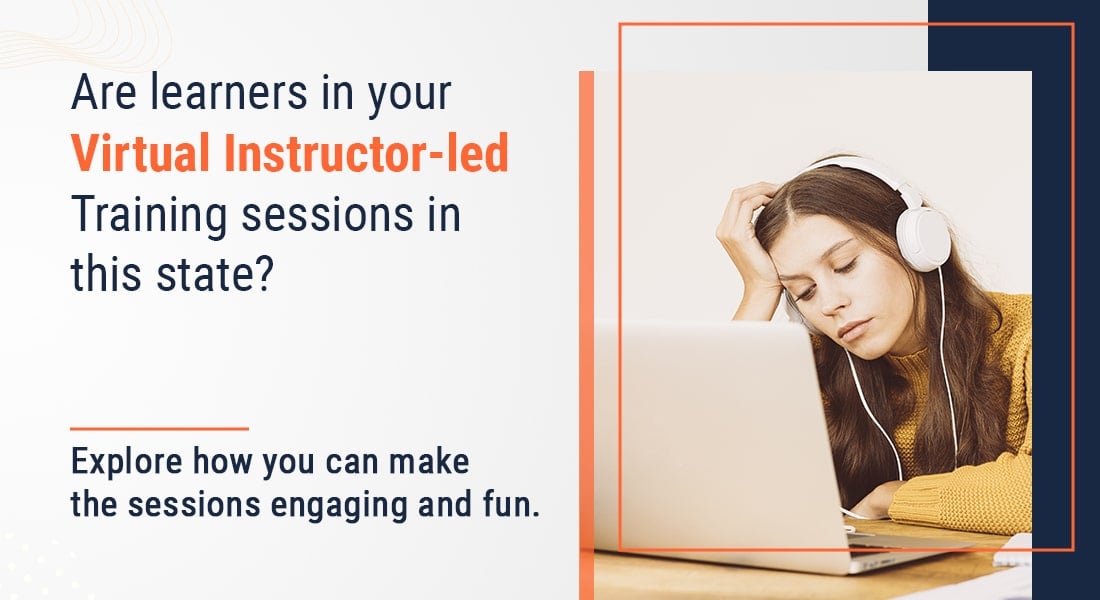VILT for Remote Employees — How to Ensure Unforgettable Learning Experiences

The landscape of corporate training has undergone a significant transformation with the rise of remote work. As organizations adapt to distributed teams, Virtual Instructor-Led Training (VILT) has emerged as a powerful tool for training remote employees. Unlike traditional in-person training, VILT leverages technology to deliver engaging and interactive learning experiences regardless of geographical boundaries. Despite being delivered virtually, VILT keeps the essence of classroom training intact, by giving it a human touch. In this blog, we'll delve into why VILT is apt for training remote employees and explore best practices to design VILT sessions that ensure unforgettable learning experiences.
VILT is a Boon for Remote Employee Training
Follow these best practices to design unforgettable VILT sessions:
- Focus on facilitating learner participation
- Remember personalization is the key
- Ensure sound technology for seamless training delivery
- Provide ongoing support via performance support tools
Why VILT is Apt to Train Remote Employees — 3 Key Reasons
Flexibility and Accessibility
VILT offers unparalleled flexibility and accessibility, making it ideal for remote employee training. Employees can participate in training sessions from anywhere with an internet connection, eliminating the need for travel and accommodation expenses. This accessibility ensures that training programs are inclusive, reaching employees across different time zones and locations. Moreover, VILT allows for on-demand access to recordings, resources, and supplementary materials, enabling employees to revisit and reinforce their learning at their convenience.
→ Download Checklist: A to Z of Launching a VILT Program
Scalability and Consistency
Scalability is a critical factor in training remote teams, especially in rapidly growing organizations. VILT enables seamless scalability by accommodating large numbers of participants without logistical constraints. It ensures consistency in training delivery, ensuring that all employees receive the same high-quality learning experience regardless of their location. This consistency is crucial for maintaining standardization in knowledge and skills across the organization, fostering a cohesive corporate culture and alignment with strategic business goals.
Enhanced Engagement and Interactivity
Unlike traditional eLearning modules, VILT promotes enhanced engagement and interactivity through real-time interactions with instructors and peers. Learners get the opportunity to interact with the trainer and clear their doubts and queries. Features such as live polls, breakout rooms, virtual whiteboards, and chat functionalities create an immersive learning environment. These interactive elements not only capture participants' attention but also encourage active participation, collaboration, and knowledge sharing. Additionally, VILT sessions can incorporate multimedia content, simulations, and gamification to enhance learning retention and motivation among remote employees.

How to Design Memorable VILT Sessions for Remote Employees — 4 Best Practices
Focus on Facilitating Learner Participation
Ditch boring lectures and blah PowerPoint presentations. Involve learners in the learning process. The best way to grab the attention of your learners at the beginning of a VILT session is to plan an interesting icebreaker. Narrate a personal anecdote or ask a question. Humor never fails to play its charm — play a funny video around the training topic.
Encourage active participation by incorporating interactive activities such as group discussions, case studies, role-playing scenarios, and Q&A sessions. Interactive elements stimulate critical thinking, problem-solving skills, and knowledge application, fostering a deeper understanding of the subject matter. Remote employees work in isolated environments. Provide opportunities for peer collaboration and feedback, creating a collaborative learning community among remote employees.
Remember Personalization is the Key
All learners are unique and so are their learning styles and preferences. It is essential to understand the unique learning needs of your audience. Conduct pre-assessments to gauge existing knowledge levels and customize content accordingly. Tailor VILT sessions to meet the individual needs and learning objectives of remote employees.
Incorporate real-world examples and industry-specific scenarios relevant to participants' roles and responsibilities. For instance, If you are addressing a group of Gen Z learners, include videos and gamification elements to make the content appealing to the youth. Personalization enhances engagement, relevance, and applicability of the training content, maximizing learning outcomes and retention.
Ensure Sound Technology for Seamless Training Delivery
Sound technological infrastructure is the backbone of a VILT session. Invest in reliable technology platforms and tools to ensure seamless VILT delivery. Choose a user-friendly virtual learning platform that supports interactive features, multimedia content, and real-time communication. Adobe Connect, Microsoft Teams, and Zoom are some of the popular VILT platforms that have modern interactive features to ensure immersive learning experiences.
Train your trainer. Despite being subject matter experts, sometimes they lack technical expertise. Make sure to acclimatize them with the VILT platforms. Conduct dry runs to check the readiness and execution of the VILT session. Conduct technical checks and provide guidelines for participants to familiarize themselves with the platforms before the training sessions. Technical support staff should be readily available during sessions to address any connectivity issues and ensure uninterrupted learning experiences.

Provide Ongoing Support Via Performance Support Tools
Extend learning beyond VILT sessions with ongoing performance support tools such as job aids, microlearning modules, and online resources. Provide access to a centralized knowledge base or learning management system (LMS) where employees can access training materials, job aids, FAQs, and community forums. Make the VILT session recordings available for your learners to revisit complex modules.
Encourage self-directed learning and continuous skill development through curated content and personalized learning paths. Performance support tools empower remote employees to apply their learning in real-world scenarios, enhancing job performance and productivity.
Here’s a bonus!
Watch this video for ten tips to ensuring sticky learning in VILT.
VILT for Continual and Undisrupted Training for Remote Employees
Virtual Instructor-Led Training has emerged as a transformative approach to training remote employees, offering flexibility, scalability, and enhanced engagement. By following the above-discussed best practices, you can ensure that VILT becomes an unforgettable learning experience for your remote workforce. Embracing VILT not only enables organizations to adapt to remote work dynamics but also fosters a culture of continuous learning and skill development, driving business success in the digital age.
Are you all set to launch your new and improvised VILT program? Here’s a checklist to validate your readiness. Grab it now to ensure a foolproof VILT program that awes your remote workforce.





